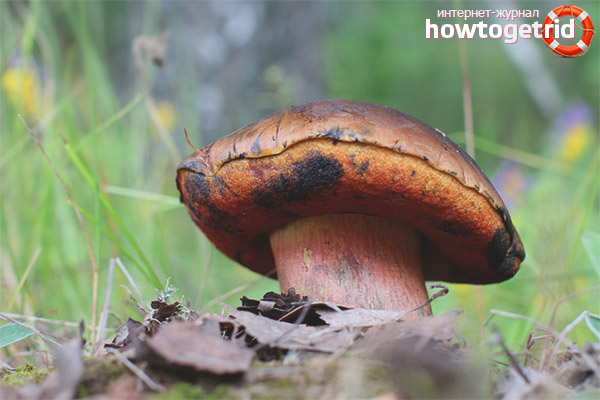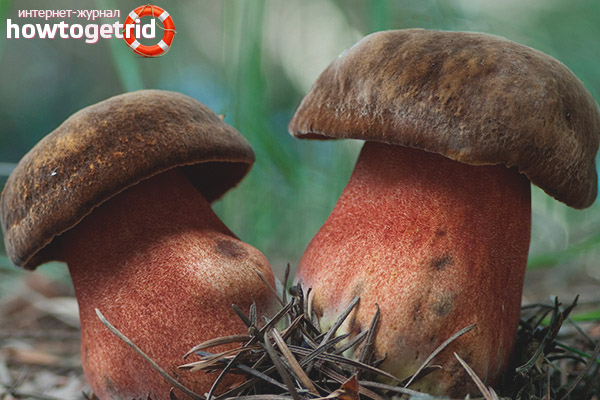The content of the article
Speckled oak (Boletus erythropus) is a member of the Boletovy family. It is considered conditionally edible. It has other names:
- red-footed boletus;
- bruise;
- subdubic mushroom;
- grain-footed boletus;
- grain-footed oak;
- the duvet.
Description
The cap of this mushroom is dull, resembles velvet, maybe with mucus. Its size ranges from five to twenty centimeters. In shape, it resembles a pillow or has a more rounded, spherical shape. The hat is dark brown, black-brown, dark brown, sometimes with an olive or red tint. As the fungus ages, it becomes naked. With pressure or damage to its surface, this place darkens, takes a bluish tint.
Inside the mushroom is yellow. When a mushroom picker cuts it off, the cut-off point almost immediately turns blue or with a greenish tint. The leg has the shape of a barrel-shaped or cylindrical, can thicken to the bottom with the growth of the oak. The inside of the legs is brown or red, taste and smell are absent. Outside are reddish scales and specks. Her color is red and yellow, no mesh. Sizes in height from five to fifteen centimeters, in diameter - up to four centimeters.
If you look under the hat, you can see olive, yellow-green or yellowish tubes. There are also small rounded pores that are yellow in color, reddish or orange as the fungus ages. Also darken when injured. The spores are brown-olive, their shape is fusiform, to the touch - smooth.
Places where speckled oak tree grows
He likes to settle under such trees as beeches, Christmas trees, oaks, fir. Its roots form a symbiosis with the rhizome of trees. It also grows on marshy soil, along with moss. The choice of place of growth is influenced by his love of acidic soil. New mushrooms appear from May to October.
Is it possible to eat speckled oak
These mushrooms are conditionally edible. To eat them, you need to cook for about 15 minutes, and then pour the water in which they were cooked. After that, from the oak trees you can cook various dishes, use for side dishes or sauces. After cooking, they practically do not decrease in size. These mushrooms have a lot of fragrant pulp. The dishes are very tasty when frying, the beneficial properties are not lost, and a pleasant aroma comes from them. In addition, oaks can be cooked in any form: pickled, dried, salted. Mushrooms for every taste.
Similar mushrooms
These mushrooms, like many others, have many "brothers", similar to themselves. It is necessary to know and be able to distinguish between them. These include:
- Yellow boletus usually grows in western Europe. It differs from a bruise in brownish-yellow color.
- Dubovik Kele - rarely found. Prefers calcareous soils. It differs in the color of the hat: it is lighter and brownish yellow.
- An olive-brown oak tree differs with a speckled net on the leg.
- Satanic mushroom - is a poisonous species. In this case, it is especially important not to confuse the mushrooms. It differs from an oak tree in an unpleasant odor. In addition, on the cut it does not turn blue immediately, at first it turns red.
Useful properties of mottled oak
Dubovik contains useful substances:
- Trace elements: copper, zinc, manganese, iron.Copper promotes the formation of blood cells, is involved in the metabolic processes of the body and the synthesis of pituitary hormones. Zinc improves the functioning of the gastrointestinal tract. Increases the absorption of various nutrients, improves digestion due to accumulation in the pancreas. Iron is necessary for the formation of hemoglobin, which carries oxygen in the body. In a very small portion of mushrooms, a whole daily dose of trace elements is placed.
- Amino acids improve memory, mental abilities, lead to normal coordination of movements.
- Beta glucans are beneficial for the immune system and have a negative effect on cancer cells.
In addition, these mushrooms reduce the risk of atherosclerosis.
The use of a speckled oak tree!
It must be remembered that the mushrooms are conditionally edible and should be used with caution. Children under the age of twelve cannot eat mushrooms. The fact is that they are specific and “heavy” food. They contain chitin, which has a structure that is intermediate between plant and animal. It is useful for adults, but is not absorbed in the digestive tract of children.
Video: speckled oak tree (Boletus erythropus)











Submit